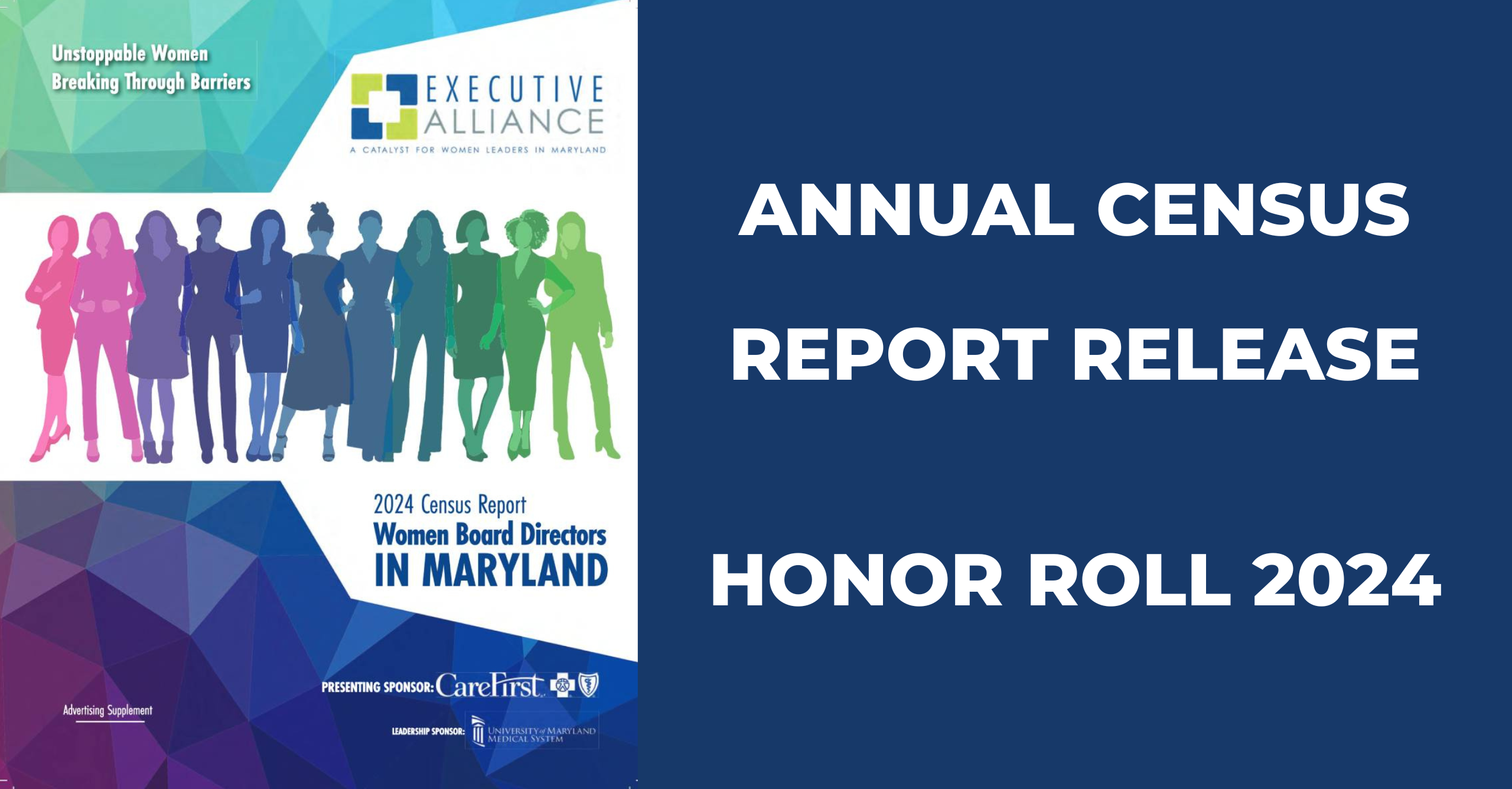Executive Alliance seeks to empower and diversify women leaders as they grow and develop through their careers. Since 1993, Executive Alliance has been a catalyst for women leaders in the greater Baltimore area. We achieve this mission partly by measuring the progress women have made through our Annual Census Report of Women Board Directors in Maryland, which was released March 20 at our Honor Roll event.
In the Census Report, Executive Alliance has been measuring and reporting the number of women who hold director seats for over 17 years. Other areas tracked include C-Suite, most highly compensated, new directors, industry diversity, nominating committee, age, ethnic/racial diversity, new companies & more. The Census includes public companies headquartered in MD and traded on one of the three major exchanges (NYSE, NYSE American or Nasdaq) and excludes funds and early stage blank-check companies. This is the first year we have tracked overall diversity in the boards, and the second year we have accepted applications directly from companies applying for our prestigious Honor Roll designation which is designed to recognize and celebrate companies and organizations that are creative and supportive in recruitment, development, support and advancement of women in the workplace and corporate boards. Each Honor Roll award organization has AT LEAST 30% of their executive leadership AND 30% of their board of director seats held by women.
Key Takeaways from the 2024 Census
Examining the 80 publicly traded companies in Maryland (which represent 673 director seats), Executive Alliance finds that 26% of director seats in Maryland are held by women, a 3% increase from last year. This is a big change from 15 years ago when that number was only 9%.
The pace of change has been accelerating in recent years; however, the pendulum could swing back as California’s SB826, which required publicly-traded companies headquartered in California to have multiple women sit on boards by a certain date, was ruled unconstitutional. That law was extremely effective, doubling the percentage of board seats held by women. Without legislative oversight, the rate of change could diminish or backslide.
Executive Alliance found that Maryland companies significantly lag behind national averages for gender diversity for board members. Underrepresented minorities comprise 18% of all director seats in Maryland, compared to 24% of the S&P 500 director seats. A bright spot: when public boards in Maryland add new directors, increasingly, they are adding women. Last year, 33% of the new independent board directors were women, and this year, that number increased significantly to 53%. In the S&P 500, only 46% of the new independent directors are women.
Balancing that bright spot, 80% of the new independent male directors are white, whereas 52% of incoming women directors are white meaning that public boards are achieving racial diversity through new women directors.
Where are the women?
Surprisingly, there are eight public companies in Maryland that have NO women board directors, and of those, six have no female executives either. Those companies are Bullfrog AI Holdings, Inc., CASI Pharmaceuticals, Inc., Connexa Sports Technologies, Inc., IGC Pharma, Inc (formerly India Globalization, Inc.), My MD Pharmaceuticals, Inc., Rekor Systems, Inc., Theriva Biologics, Inc. (previously known as Biologics, Inc.), and Universal Security Instruments, Inc. Since 2020, the S&P 500 has had no all-male boards.
Certain industries in Maryland also lag significantly behind in terms of women’s representation. Executive Alliance found that publicly-traded companies headquartered in Maryland in the following sectors had few to no women on boards and in executive leadership positions. Three industries had no women board directors in any company in the sector. While all Construction, Health Care & Social Assistance, and Mining companies had no women executives, the number of companies in the industry sector was only two for Construction, and one each for Health Care & Social Assistance and Mining. Of the 35 companies in the Manufacturing sector, five (71%) had no women directors and 12 (43%) had no women executives.
Although there are bright spots, Maryland board rooms and executive suites have a long way to go until there is gender and racial parity. That’s where Executive Alliance comes in.
What’s next?
Executive Alliance seeks to change the conversation about women leaders through Advocacy, Education and Mentorship. There are many ways to become involved in the work we do. For women at the mid-level of their careers, consider our Effective Impact Mentoring program (applications will close in early June), or attending our In the Room Mentoring event May 9. For senior level executive women leaders, consider membership in the organization. To become inspired by the unstoppable women in Maryland, mark your calendar for our Women of Excellence celebration November 13. Stay at the forefront of women leaders in Maryland by subscribing to our free monthly Accelerate Women newsletter. More information on all programs may be found at executivealliance.org.
Together, we can change the outlook for Maryland’s professional women and ensure that all women are fully represented at the highest levels of business, civic and government leadership.


